Promise Pegasus J2 Review: The Smallest High Performance Thunderbolt Drive
by Anand Lal Shimpi on September 2, 2012 1:00 PM ESTPerformance
I feel like the most common usage model for any Thunderbolt storage device is for accessing large files that would benefit from high speed sequential IO (e.g. movies, photos, music). For those use cases, even the big hard drive based Thunderbolt enclosures perform fine if you just throw enough drives at the problem. While mechanical storage can hardly deal with heavy random IO, sequential speeds are still acceptable - especially in a multi-drive RAID setup. With 6Gbps SSDs however, it only takes a couple to deliver outstanding sequential IO performance. Despite the Pegasus J2's diminutive size, it delivers sequential IO performance that rivals the Pegasus R6:
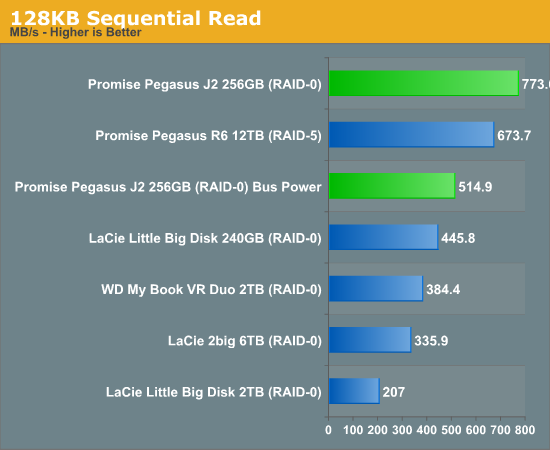
Sequential read speed is a strong suit of the J2. When running on external power the J2 is even faster than the 12TB R6 at nearly 800MB/s. Even on bus power the J2 is among the fastest Thunderbolt enclosures we've ever tested, and you can fit it in your pocket.
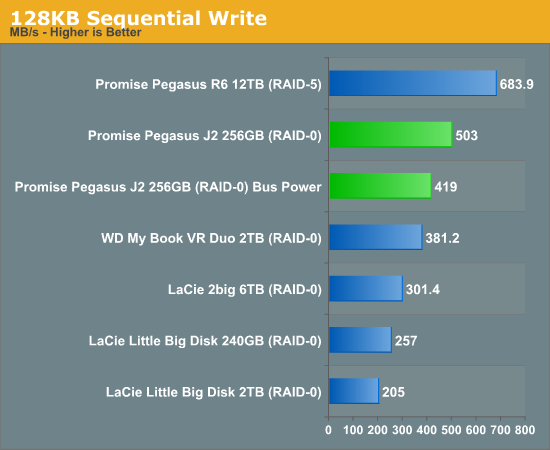
Write performance isn't as solid, which is unfortunately due to the Phison controllers. The J2 is still fast here but the R6 is faster, and some of the hard drive based solutions get close when running on bus power alone.
QuickBench echoes what Iometer tells us about sequential IO performance on the Pegasus J2:
We see the same drop when we go to bus power on the J2:
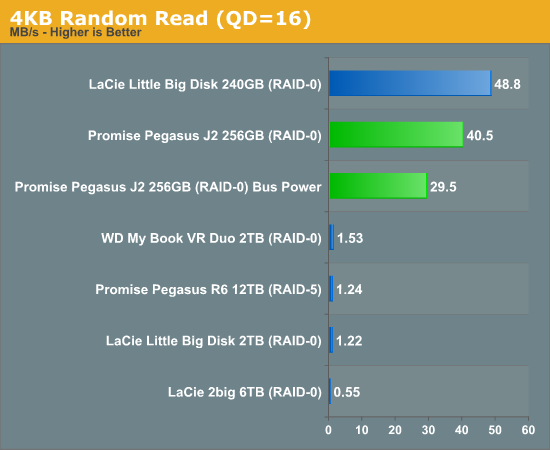
Random read performance is pretty good on the J2, although LaCie's SSD based Little Big Disk manages better performance thanks to its use of Intel SSD 320s. There's no competition from the hard drive based enclosures.
The real problem is random write performance:
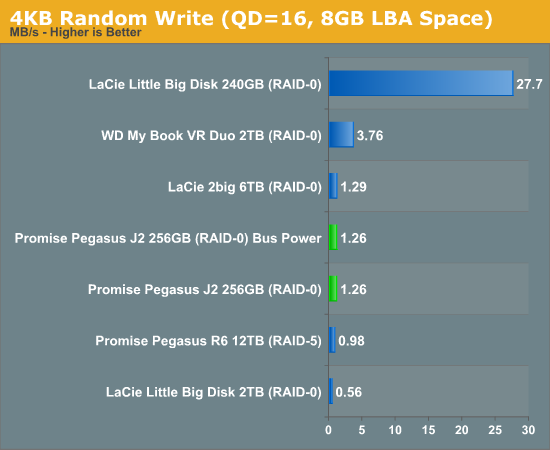
I actually had to stop the random write test early because performance got too erratic. Under heavy random writes the Phison controllers easily drop into the 200 - 400KB/s range. It's bad. The other problem is if you're writing anything but sequential files to the drive, you'll see a reduction in performance over time. The Phison controllers seem to do an ok job of recovering performance after sequential write passes, which is good given that there's no native TRIM support for the drive under OS X.
TRIM enabler will work on the drive however, and at least pass TRIM through if you format the individual RAID slices. It's unclear to me whether or not Apple's software RAID-0 will pass TRIM through to an array.


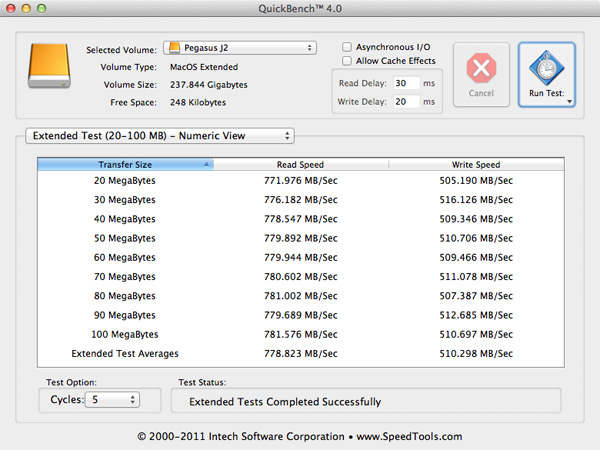

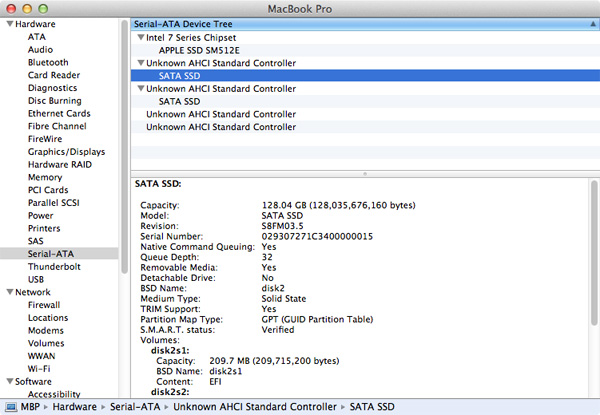








24 Comments
View All Comments
likethesky - Saturday, September 8, 2012 - link
Why go TB, when USB 3.0 is just about as fast? Or am I wrong about that for SSDs?Zds - Sunday, September 9, 2012 - link
USB 3.0 is 5Gbps, TB is 8Gbps - and this device uses all that on sequential reads, hitting 770MB/s.repoman27 - Tuesday, September 11, 2012 - link
Well, SuperSpeed USB is 5 Gbps with 8b/10b encoding, so really only 4 Gbps, and realistically tops out at 400 MB/s due to protocol overhead. If you're using USB 3.0 drivers and/or hardware that only support standard Bulk Only Transfer mode, throughput will be considerably less than that.Thunderbolt is 2x 10.3125 Gbps channels per port with 64b/66b encoding which brings them down to 10 Gbps. While most Thunderbolt controllers have a PCIe 2.0 x4 back end, the Port Ridge controller used in this device only provides a single 10 Gbps Thunderbolt channel paired with a PCIe 2.0 x2 connection.
A PCIe 2.0 lane is 5 Gbps but also uses 8b/10b and has its own protocol overhead, which in practice results in throughput of about 400 MB/s, although better results can be achieved with larger TLP payload sizes.
So any Port Ridge based Thunderbolt device would be limited to around 800 MB/s, which is exactly what we see here.
There's one more element to the equation though, and that's the SATA controller. Most USB 3.0 to SATA bridges on the market at the moment only support SATA 3Gb/s, which limits them to less than 300 MB/s (8b/10b strikes again). Meanwhile, most SATA 6Gb/s controllers used in Thunderbolt devices only have a PCIe 2.0 x1 connection which drags them down to 400 MB/s. Which makes me confused about the Pegasus J2's performance, because that's what we would expect from a single ASM1061 controller. I'm guessing there's a second one on that board somewhere.
Zds - Sunday, September 9, 2012 - link
What are the dimensions of the device? It feels strange to applaud the small size, but not tell _how_ small exactly it is..